The basal proton conductance of mitochondria depends on adenine nucleotide translocase content
- PMID: 16076285
- PMCID: PMC1316271
- DOI: 10.1042/BJ20050890
The basal proton conductance of mitochondria depends on adenine nucleotide translocase content
Abstract
The basal proton conductance of mitochondria causes mild uncoupling and may be an important contributor to metabolic rate. The molecular nature of the proton-conductance pathway is unknown. We show that the proton conductance of muscle mitochondria from mice in which isoform 1 of the adenine nucleotide translocase has been ablated is half that of wild-type controls. Overexpression of the adenine nucleotide translocase encoded by the stress-sensitive B gene in Drosophila mitochondria increases proton conductance, and underexpression decreases it, even when the carrier is fully inhibited using carboxyatractylate. We conclude that half to two-thirds of the basal proton conductance of mitochondria is catalysed by the adenine nucleotide carrier, independently of its ATP/ADP exchange or fatty-acid-dependent proton-leak functions.
Figures
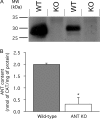
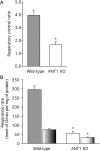
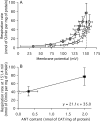
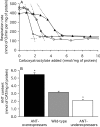

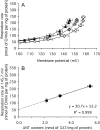




Similar articles
-
Energization-dependent endogenous activation of proton conductance in skeletal muscle mitochondria.Biochem J. 2008 May 15;412(1):131-9. doi: 10.1042/BJ20080006. Biochem J. 2008. PMID: 18251717 Free PMC article.
-
Uncoupling protein and ATP/ADP carrier increase mitochondrial proton conductance after cold adaptation of king penguins.J Physiol. 2004 Jul 1;558(Pt 1):123-35. doi: 10.1113/jphysiol.2004.063768. Epub 2004 May 14. J Physiol. 2004. PMID: 15146050 Free PMC article.
-
High membrane potential promotes alkenal-induced mitochondrial uncoupling and influences adenine nucleotide translocase conformation.Biochem J. 2008 Jul 15;413(2):323-32. doi: 10.1042/BJ20080321. Biochem J. 2008. PMID: 18426390 Free PMC article.
-
The ADP and ATP transport in mitochondria and its carrier.Biochim Biophys Acta. 2008 Oct;1778(10):1978-2021. doi: 10.1016/j.bbamem.2008.04.011. Epub 2008 May 2. Biochim Biophys Acta. 2008. PMID: 18510943 Review.
-
The causes and functions of mitochondrial proton leak.Biochim Biophys Acta. 1994 Aug 30;1187(2):132-9. doi: 10.1016/0005-2728(94)90099-x. Biochim Biophys Acta. 1994. PMID: 8075107 Review.
Cited by
-
Thyroid Hormone Mediated Modulation of Energy Expenditure.Int J Mol Sci. 2015 Jul 16;16(7):16158-75. doi: 10.3390/ijms160716158. Int J Mol Sci. 2015. PMID: 26193258 Free PMC article. Review.
-
Undernutrition during pregnancy in mice leads to dysfunctional cardiac muscle respiration in adult offspring.Biosci Rep. 2015 Apr 10;35(3):e00200. doi: 10.1042/BSR20150007. Biosci Rep. 2015. PMID: 26182362 Free PMC article.
-
Mitochondrial Respiration-Dependent ANT2-UCP2 Interaction.Front Physiol. 2022 May 25;13:866590. doi: 10.3389/fphys.2022.866590. eCollection 2022. Front Physiol. 2022. PMID: 35694398 Free PMC article.
-
One-carbon metabolizing enzyme ALDH1L1 influences mitochondrial metabolism through 5-aminoimidazole-4-carboxamide ribonucleotide accumulation and serine depletion, contributing to tumor suppression.Sci Rep. 2023 Aug 18;13(1):13486. doi: 10.1038/s41598-023-38142-5. Sci Rep. 2023. PMID: 37596270 Free PMC article.
-
Low-Dose Sorafenib Acts as a Mitochondrial Uncoupler and Ameliorates Nonalcoholic Steatohepatitis.Cell Metab. 2020 May 5;31(5):892-908.e11. doi: 10.1016/j.cmet.2020.04.011. Cell Metab. 2020. PMID: 32375062 Free PMC article.
References
-
- Brand M. D., Chien L. F., Ainscow E. K., Rolfe D. F. S., Porter R. K. The causes and functions of mitochondrial proton leak. Biochim. Biophys. Acta. 1994;1187:132–139. - PubMed
-
- Brand M. D. The proton leak across the mitochondrial inner membrane. Biochim. Biophys. Acta. 1990;1018:128–133. - PubMed
-
- Rolfe D. F. S., Brand M. D. Contribution of mitochondrial proton leak to skeletal muscle respiration and to standard metabolic rate. Am. J. Physiol. 1996;271:C1380–C1389. - PubMed
-
- Rolfe D. F. S., Brand M. D. The physiological significance of mitochondrial proton leak in animal cells and tissues. Biosci. Rep. 1997;17:9–16. - PubMed
-
- Rolfe D. F. S., Newman J. M., Buckingham J. A., Clark M. G., Brand M. D. Contribution of mitochondrial proton leak to respiration rate in working skeletal muscle and liver and to SMR. Am. J. Physiol. 1999;276:C692–C699. - PubMed
Publication types
MeSH terms
Substances
Grants and funding
LinkOut - more resources
Full Text Sources
Other Literature Sources
Molecular Biology Databases

